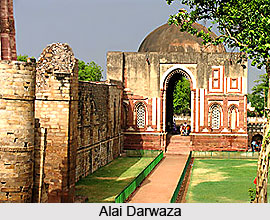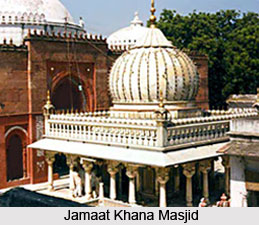 The Islamic architecture flourished under the aegis of the ruling power of the Muslim rulers of Delhi which was maintained for a period of over three and a half centuries. The origin of these architectures was from distant parts of Western Asia, which prevailed in India from the twelfth to the sixteenth centuries. The architecture during Khalji dynasty was in the formative stage of building art that made a little progress in the last years of the thirteenth century in India. Khaljis were the second Muslim dynasty and ruled the Delhi Sultanate from 1290 to 1320. Under the reign of Ala-ud-din Khalji, who ascended the throne of Delhi in 1296, a crucial development in the field of architecture took place. He was considered as a great patron of Islamic architecture. This ruler`s most important building projects were the extension of the Qutb mosque and the construction of Siri Fort in Delhi.
The Islamic architecture flourished under the aegis of the ruling power of the Muslim rulers of Delhi which was maintained for a period of over three and a half centuries. The origin of these architectures was from distant parts of Western Asia, which prevailed in India from the twelfth to the sixteenth centuries. The architecture during Khalji dynasty was in the formative stage of building art that made a little progress in the last years of the thirteenth century in India. Khaljis were the second Muslim dynasty and ruled the Delhi Sultanate from 1290 to 1320. Under the reign of Ala-ud-din Khalji, who ascended the throne of Delhi in 1296, a crucial development in the field of architecture took place. He was considered as a great patron of Islamic architecture. This ruler`s most important building projects were the extension of the Qutb mosque and the construction of Siri Fort in Delhi.
Islamic architecture in India was introduced by Qutb-ud-din Aibak in 1191, the first Slave King from the Slave dynasty. He was the most active patron of the building art and his constructions were of the greatest significance in laying the foundations of the style. Later the tradition of the Islamic architecture was followed and continued by the Khalji dynasty. Architecture during Khalji dynasty was a lot contoured by Ala-ud-din Khalji. He reconstructed the Qutb mosque erected by his predecessors. He extended its northern end and raised a colossal minar. The proportion of the minar was double, compared to those of the one set up by the Slave Kings a century before. The main walls of the mosque are still visible; however, most of its parts are present with its huge core of rubble.
 The architecture of Khalji dynasty was a great composition of creative knowledge which was completed in an intelligent supervision. The Qutb Minar and the structural element of the Alai Darwaza echo this truth. Alai Darwaza was completed in the year 1305. This structure is the southern entrance hall to the courtyard, a gateway of Ala- ud-din Khalji. Some fresh influence was present due to the assistance of the experts and mature developments were done to the building. The Alai Darwaza is a unique building art due to the shape and inventiveness of the arches, in the method of its walling, in the conception and support system for the dome and in the design of the surface decoration. The Alai Darwaza consists of many indigenous features throughout its design. Its fabric runs in the Indian manner, sometimes in the form of a mere border, at others comprising considerable parts of the pattern. It is the skilful fusion of the two modes that has produced in this building such an outstanding work of art. Ala- ud-din Khalji created four entrances to the Alai Darwaza mosque two of which were to be on the long eastern side, and one each on the north and south. However, only the southern entrance was completed comparing to the other unfinished portions. To view the progress of the work from his royal residence, the Sultan constructed the southern quarter which was one of the most artistic structural achievements produced under the Islamic rule. The designs of the three outer faces of Alai Darwaza are similar, each containing a tall archway over a flight of steps leading to the higher floor of the interior. Below is a platform, its vertical sides gracefully carved in varied bands, while the surface of the wall above is divided into two stories and then again into upright rectangular panels, the two lower being arched recesses with stone grilles. These are accomplished with the combination of red sandstone and white marble, along with the arabesques and decorative inscriptions enriching the whole. The outstanding Islamic architecture of the mosque consists of a rare kind of arch constructed in a horse-shoe shape structure. Around its outlines is a band of inscription carved in white marble, while in the inner curve is a "fringe" of spear-heads, and in the spandrels are sockets, typical of the archways in the buildings of the Saljuqs. Supporting the arch are slender nook-shafts, carved and moulded, and the whole is placed in a rectangular frame work bordered with various repeating patterns and writings in white marble. The surfaces are intricately carved with the coloured plastic scheme. The Alai Darwaza as a whole is a wonderful Islamic architecture in the Indigenous style. The structure not only depicts the finesse of Islamic architecture but also murmurs the brilliance of the development of architecture during Khalji dynasty.
The architecture of Khalji dynasty was a great composition of creative knowledge which was completed in an intelligent supervision. The Qutb Minar and the structural element of the Alai Darwaza echo this truth. Alai Darwaza was completed in the year 1305. This structure is the southern entrance hall to the courtyard, a gateway of Ala- ud-din Khalji. Some fresh influence was present due to the assistance of the experts and mature developments were done to the building. The Alai Darwaza is a unique building art due to the shape and inventiveness of the arches, in the method of its walling, in the conception and support system for the dome and in the design of the surface decoration. The Alai Darwaza consists of many indigenous features throughout its design. Its fabric runs in the Indian manner, sometimes in the form of a mere border, at others comprising considerable parts of the pattern. It is the skilful fusion of the two modes that has produced in this building such an outstanding work of art. Ala- ud-din Khalji created four entrances to the Alai Darwaza mosque two of which were to be on the long eastern side, and one each on the north and south. However, only the southern entrance was completed comparing to the other unfinished portions. To view the progress of the work from his royal residence, the Sultan constructed the southern quarter which was one of the most artistic structural achievements produced under the Islamic rule. The designs of the three outer faces of Alai Darwaza are similar, each containing a tall archway over a flight of steps leading to the higher floor of the interior. Below is a platform, its vertical sides gracefully carved in varied bands, while the surface of the wall above is divided into two stories and then again into upright rectangular panels, the two lower being arched recesses with stone grilles. These are accomplished with the combination of red sandstone and white marble, along with the arabesques and decorative inscriptions enriching the whole. The outstanding Islamic architecture of the mosque consists of a rare kind of arch constructed in a horse-shoe shape structure. Around its outlines is a band of inscription carved in white marble, while in the inner curve is a "fringe" of spear-heads, and in the spandrels are sockets, typical of the archways in the buildings of the Saljuqs. Supporting the arch are slender nook-shafts, carved and moulded, and the whole is placed in a rectangular frame work bordered with various repeating patterns and writings in white marble. The surfaces are intricately carved with the coloured plastic scheme. The Alai Darwaza as a whole is a wonderful Islamic architecture in the Indigenous style. The structure not only depicts the finesse of Islamic architecture but also murmurs the brilliance of the development of architecture during Khalji dynasty.
Apart from the Alai Darwaza, the other architectures during Khalji Dynasty were Siri Fort, the second of the seven cities of Delhi, constructed in 1303 and the Jamaat Khana Masjid at the tomb of Nizam-ud-din Auliya, a distinguished saint of the period, erected towards the end of the Khalji rule. Several other buildings were erected near the Qutb area. One is recognised as a college and another one is the tomb of the Ala- ud-din Khalji. Another example of the Islamic architecture during the Khalji dynasty was the Ukha Masjid at Bayana in Bharatpur State, at Rajasthan. This mosque was built by Qutb-ud-din Mubarak (1316-20), the last Sultan of the Khalji dynasty.
Siri Fort in Delhi was a great example of Islamic architecture during the Khalji dynasty. It was built to protect the people from the repeated invasions of the Mongols. Apart from the palace, Siri Fort had living quarters of Khaljis and several other buildings inside it. The well-known 1,000-pillar palace of Ala-ud-din Khalji, named Hazar Sutun was also present inside the Siri Fort, however, the only existing building present inside it is the Hauz Khas. The architecture of Khalji dynasty came to an end due to the death of its last Sultan Mubarik.






































